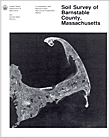The following is a map unit description from the "Soil Survey of Barnstable County, Massachusetts (Fletcher, 1993)"

SdA-Sudbury fine sandy loam, 0 to 3 percent slopes. This very deep, nearly level, moderately well drained soil is in depressions, swales, and low areas on outwash plains bordering streams, ponds, and swamps. It makes up less than 0.1 percent (121 acres) of the survey area. It is mapped mainly in the Enfield-Merrimac-Carver general soil map unit. Areas are irregular in shape and range from 5 to 40 acres in size.
Typically, the surface layer is very dark grayish brown, friable fine sandy loam about 1 0 inches thick. The subsoil is yellowish brown, friable sandy loam about 20 inches thick. It is mottled below a depth of 22 inches. The substratum extends to a depth of 65 inches or more. It is mottled. The upper 6 inches is strong brown, loose sand; the next 3 inches is light brownish gray, friable loamy fine sand; the next 6 inches is brownish yellow, loose sand; and the lower 20 inches is light yellowish brown, loose gravelly coarse sand.
Included with this soil in mapping are small areas of Amostown, Deerfield, Merrimac, and Pipestone soils. Also included are small areas where the lower part of the subsoil is very fine sandy loam. Included soils make up about 25 percent of this unit.
Permeability is moderately rapid in the subsoil of the Sudbury soil and moderately rapid or rapid in the substratum. Available water capacity is moderate. The seasonal high water table is at a depth of 1.5 to 3.0 feet in late fall, in winter, in early spring, and after periods of heavy precipitation.
Most areas are in open fields or support shrubby vegetation. Some areas are wooded.
This soil is well suited to cultivated crops. Good tilth can be easily maintained. Planting or harvesting may be delayed by the seasonal high water table. A drainage system is needed for maximum crop yields and the most efficient use of machinery. Growing cover crops and including grasses and legumes in the cropping system improve tilth. Mixing crop residue and manure into the surface layer also improves tilth.
This soil is well suited to hay and pasture. The main management objective is the prevention of overgrazing, which reduces the hardiness and density of desirable plants and exposes the soil to erosion. Proper stocking rates, timely grazing, and restricted use during wet periods help to maintain plant density and minimize surface compaction.
This soil is fairly well suited to woodland. No major hazards or limitations restrict woodland management. Minimizing surface disturbance helps to retain a spongelike mulch of leaves, which absorb precipitation and maintain the limited moisture supply. Removal or control of competing vegetation helps to obtain the best growth of newly established seedlings. The most common trees are pitch pine, red maple, eastern white pine, and white oak.
The seasonal high water table is a limitation if this soil is used as a site for dwellings with or without basements or as a site for septic tank absorption fields. Because of the moderately rapid or rapid permeability in the substratum, the soil may not adequately filter the effluent in septic tank absorption fields. The poor filtering capacity may result in the pollution of ground water. The hazard of pollution increases with the density of housing. Additions of fill or a regional drainage system helps to overcome the wetness.